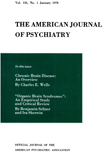Simple Schizophrenia-Syndrome or Shibboleth
Abstract
The authors review the diagnosis of simple schizophrenia, using as source material classical and contemporary textbook descriptions, a statistical survey, and case studies. The evidence demonstrates no typical premorbid history, no standard time of onset, and no characteristic pattern of symptoms or thought disorder. In essence, the data suggest that no syndrome as such exists—that it is not a reliable or valid diagnosis and cannot be used to support Bleuler's original dichotomy of "essential" and "accessory" symptoms.
Access content
To read the fulltext, please use one of the options below to sign in or purchase access.- Personal login
- Institutional Login
- Sign in via OpenAthens
- Register for access
-
Please login/register if you wish to pair your device and check access availability.
Not a subscriber?
PsychiatryOnline subscription options offer access to the DSM-5 library, books, journals, CME, and patient resources. This all-in-one virtual library provides psychiatrists and mental health professionals with key resources for diagnosis, treatment, research, and professional development.
Need more help? PsychiatryOnline Customer Service may be reached by emailing [email protected] or by calling 800-368-5777 (in the U.S.) or 703-907-7322 (outside the U.S.).



